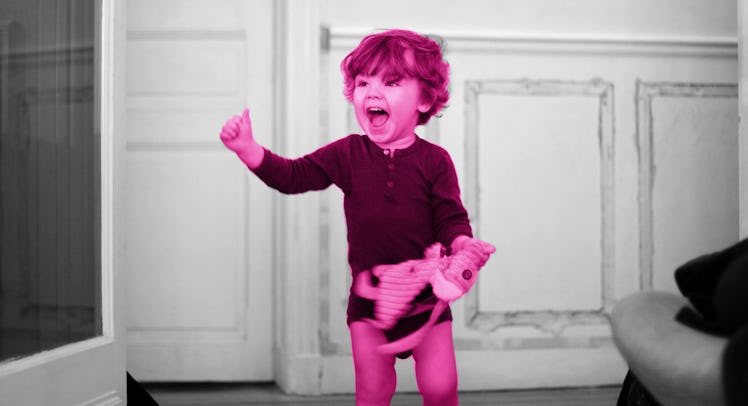How to Get a Toddler to Stay Quiet and Use Their Indoor Voice
Staying home and yelling at a kid to be quiet isn’t the way to teach them how to use an inside voice. Going out and modeling good behavior is.

Around the time a kid starts discovering the freedom of walking, they also discover the power of their voice. As they collect words, toddlers have a tendency to hurl them against their parents and out into the ether. For the most part, this is pure exploration — like an incredibly stupid form of echolocation. Not only does a voice sound different at varying volumes in different environments, it can also cause wild variety reactions from parents and bystanders. This is all incredibly interesting to a toddler and fantastically inconvenient for parents. Fortunately, it’s possible to turn down the volume (at least some of the time) by supplying some strategic guidance.
“As parents are engaging with the child, they can change their tone of voice based on the social environment and talk about where they are as they enter different social settings,” explains Ana Alvarez, MSW, a family engagement specialist at the Los Angeles-based education advocacy nonprofit Child360. “The learning can begin even with newborns.” She adds that newborns are very keyed into parents tone and facial expression, which means that teaching context is sort of inevitable anyway.
RELATED: How I Finally Realized That I’m Enabling My 4-Year-Old’s Bad Behavior
This means that, in order to train a kid to use their indoor voice, it’s important to get out and wander around. Kids are only going to understand how to talk in libraries, grocery stores, court hearings, jam band concerts, and dimly lit caverns if their parents have taken them to those places and talked about social norms. Call it a “Volume Tour.”
Luz Castellanos, MSW, who also works as a family engagement specialist with Child360, puts a finer point on the outing. “Exposing children to different environments at a year or two old is ideal,” she says. “It’s important to start showing kids what a quiet space or loud space is and putting words to it.”
But, Castellanos stresses, not all kids are built the same. She notes that it’s incredibly important for parents to understand their child’s temperament. After all, some kids who are naturally predisposed to loudness might struggle more than others when entering a quiet space. “Don’t set yourself or your child up for failure,” she urges. “If you have an active child and you’re trying to force them to be the submissive quiet child, that might not happen.”
MORE: The 7 Best Baby Monitors That Track Every Scream, Snore, And Heartbeat
And it’s possible that when an active child can’t calm down in a quiet space, a parent might get agitated. But getting loud in quiet space because a child won’t get quiet doesn’t really do much good. The better option? Take a deep breath and find a different place.
“We have to be able to self-regulate,” says Alvarez. “Acknowledge what you’re feeling and think it through before disciplining a child. It’s important in any setting for a parent to talk about what they’re feeling by using emotional vocabulary so children can make a connection and learn.”
Using emotional vocabulary means parents letting a kid know they’re feeling “sad” or “disappointed” about inappropriate loudness. But it also means catching kids using appropriate noise levels and letting them know it makes a parent feel “happy” or “proud.” Acknowledging the appropriate behavior is particularly powerful and an excellent habit for parents to develop.
All of this said, Castellanos also stresses that sometimes parents just need to trust their parenting and chill out. “There are some situations where your child isn’t going to be the quiet one in the room and you have to be okay with that,” she says. “Don’t be concerned with perceived judgment. Be patient. Be kind and recognize it’s a learning process.”
This article was originally published on